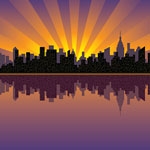The Way We Were: The Darker Days of the Upper West Side
MARCH 15, 2011
The Upper West Side has changed more since the 1970s than perhaps any other Manhattan neighborhood.
Those who knew the neighborhood in the city’s darker days note the changes; it’s certainly safer. In her post, “Upper West Side Then and Now,” one former resident writes, “In the 1960s, received wisdom stated that to wander onto 85th Street or onto Columbus Avenue after dark was to risk death or at least a good mugging. Now the area is peaceful morning, noon and night, and newly-fashionable Columbus Avenue houses dozens of trendy ethnic restaurants” (Dr. Metablog). Some mourn the loss of colorful street life and resent the uniformity of the chain stores, saying that residents are younger and more prosperous, but also less diverse. In his essay, “Life in New York, Then and Now,” John Podhoretz calls the Upper West Side of his youth, “a unique small town, an integrated mixture of professors and psychoanalysts, teachers and social workers, workers and the unemployed.” (via NY Times)
Though the Upper West Side has long been home to young families, today they don’t have to double-bolt their doors for safety. David Brooks writes in the above-mentioned NY Times op-ed column post, “Children of the ’70s,” that 84th Street between Amsterdam and Columbus Avenue “…in those days was one of the most dangerous blocks in the city.” By 1990, 5,641 felonies were committed annually in the city’s 24th Precinct, according to Podhoretz. In 2009 there were 987. Today, disturbances are more likely to resemble the current spat between an area condo board and Upper Breast Side, a store that caters to breastfeeding moms.
Blogger City Girl Writes takes both those nostalgic for the old, wild Upper West, and those who would wash their hands of it, to task: “It’s clear that two versions of the Upper West Side existed during its darkest period - the one on the surface that generated bleak statistics and anxiety-producing news coverage, and another just below the radar. The next time someone asks me what it was like to grow up in New York I may just ask a question in return: ‘Which one?’”
ALSO IN NEW YORK CITY INSIDER
- 30 Park Place Vs. The Baccarat Hotel and Residences - JUL 8, 2014
- This Week in NYC Living - JUL 1, 2014
- Notable NYC Neighbors - JUN 26, 2014
- Great NYC Buildings: New in the Heights - JUN 23, 2014
- Notable NYC Neighbors - JUN 20, 2014
- Notable NYC Neighbors - JUN 17, 2014
- Building Vs. Building - JUN 9, 2014
- Notable NYC Neighbors - JUN 6, 2014
- Notable NYC Neighbors - MAY 23, 2014
- Notable NYC Neighbors - MAY 15, 2014
- Great NYC Apartment Buildings: 12 East 13th Street vs. 22 Central Park South - MAY 13, 2014
- Notable NYC Neighbors - MAY 7, 2014
- Notable NYC Neighbors - MAY 1, 2014
- Upping the Architectural Ante in NoHo - APR 22, 2014
- Great NYC Buildings: Brooklyn's Gold Coast Living - APR 15, 2014
- Notable NYC Neighbors - APR 11, 2014
- Building vs. Building - APR 10, 2014
- Notable NYC Neighbors - APR 2, 2014
- This Week in NYC Living - APR 1, 2014
- Notable NYC Neighbors - MAR 26, 2014
- View Articles By Date


 6sqft delivers the latest on real estate, architecture, and design, straight from New York City.
6sqft delivers the latest on real estate, architecture, and design, straight from New York City.
